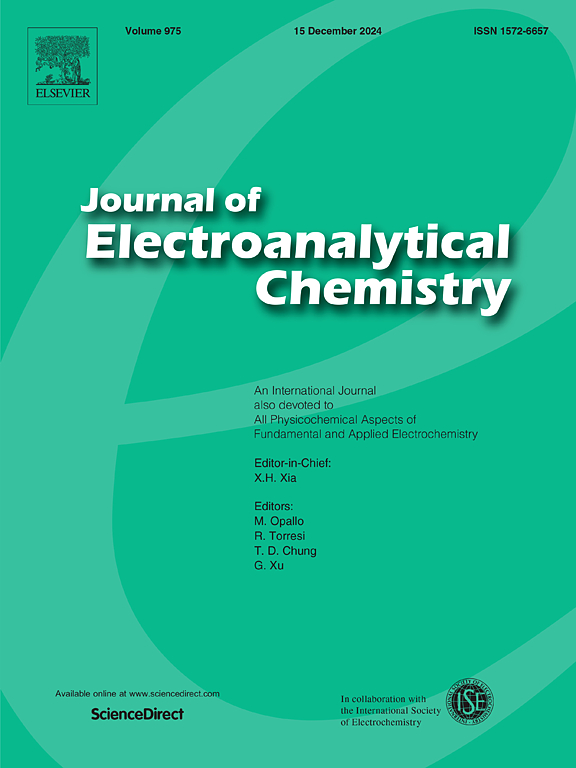通过电化学测量、热力学和DFT计算,研究了硫前驱体对湿法合成CuCo双金属硫化物的影响
IF 4.1
3区 化学
Q1 CHEMISTRY, ANALYTICAL
引用次数: 0
摘要
在本研究中,采用原位两步溶剂热技术在Ni泡沫衬底上直接生长了硫尖晶石CuCo2S4材料和CoS2/ cu复合材料。使用两种不同的硫源:五水合硫代硫酸钠(Na2S2O3.5H2O)和非水合硫化钠(Na2S.9H2O)在相同的硫浓度下调整电活性材料的类型。采用x射线衍射、x射线光电子能谱和扫描电镜技术对其物相和微观结构进行了表征。采用循环伏安法、恒流充放电法和电化学阻抗谱技术研究了其在3 M KOH水溶液中的电化学行为。钠。9H2O源合成单相CuCo2S4材料,而以含硫前驱体Na2S2O3.5H2O制备复合CoS2/ cu材料。与CuCo2S4材料相比,CoS2/ cu电极在1 Ag−1时的比电容为2195 F g−1,具有更高的电化学性能。以CoS2/ cu为正极,活性炭为负极的非对称超级电容器,在1.5 V电压窗下,功率密度为750 W kg - 1,能量密度为46.6 Wh kg - 1。基于密度泛函理论(DFT)的计算模拟验证了实验结果,表明cu /CoS2材料在可再生能源领域具有巨大的电化学应用潜力。本文章由计算机程序翻译,如有差异,请以英文原文为准。
Investigating sulfur precursor effects on wet-chemically synthesized CuCo bimetallic sulfides for supercapacitor applications via electrochemical measurement and thermodynamic and DFT calculations
In this research, an in-situ two-step solvothermal technique was used for the direct growth of thiospinel CuCo2S4 material and CoS2/CuS composite material on Ni foam substrate. The type of electroactive materials was adjusted using two distinct sulfur sources: sodium thiosulfate pentahydrate (Na2S2O3.5H2O) and sodium sulfide nonahydrate (Na2S.9H2O) at an equal concentration of sulfur. The phase and microstructure were characterized by X-ray diffractometry, X-ray photoelectron spectroscopy, and scanning electron microscopy techniques. The electrochemical behavior was studied using cyclic voltammetry, galvanostatic charge-discharge, and electrochemical impedance spectroscopy techniques in a 3 M KOH aqueous electrolyte. The Na2S.9H2O source resulted in the synthesis of single-phase CuCo2S4 material, while the composite CoS2/CuS material was obtained by the sulfur precursor of Na2S2O3.5H2O. In comparison with CuCo2S4 material, the CoS2/CuS electrode showed a higher electrochemical performance with a specific capacitance of 2195 F g−1 at 1 Ag−1 due to its finer morphology. The assembled asymmetric supercapacitor with CoS2/CuS as positive electrode and active carbon as negative electrode harvested an energy density of 46.6 Wh kg−1 at a power density of 750 W kg−1 in a voltage window of 1.5 V. Computational simulations based on density functional theory (DFT) validated the experimental findings, revealing that the CuS/CoS2 material exhibited significant potential for electrochemical applications in the renewable energy field.
求助全文
通过发布文献求助,成功后即可免费获取论文全文。
去求助
来源期刊
CiteScore
7.80
自引率
6.70%
发文量
912
审稿时长
2.4 months
期刊介绍:
The Journal of Electroanalytical Chemistry is the foremost international journal devoted to the interdisciplinary subject of electrochemistry in all its aspects, theoretical as well as applied.
Electrochemistry is a wide ranging area that is in a state of continuous evolution. Rather than compiling a long list of topics covered by the Journal, the editors would like to draw particular attention to the key issues of novelty, topicality and quality. Papers should present new and interesting electrochemical science in a way that is accessible to the reader. The presentation and discussion should be at a level that is consistent with the international status of the Journal. Reports describing the application of well-established techniques to problems that are essentially technical will not be accepted. Similarly, papers that report observations but fail to provide adequate interpretation will be rejected by the Editors. Papers dealing with technical electrochemistry should be submitted to other specialist journals unless the authors can show that their work provides substantially new insights into electrochemical processes.

 求助内容:
求助内容: 应助结果提醒方式:
应助结果提醒方式:


